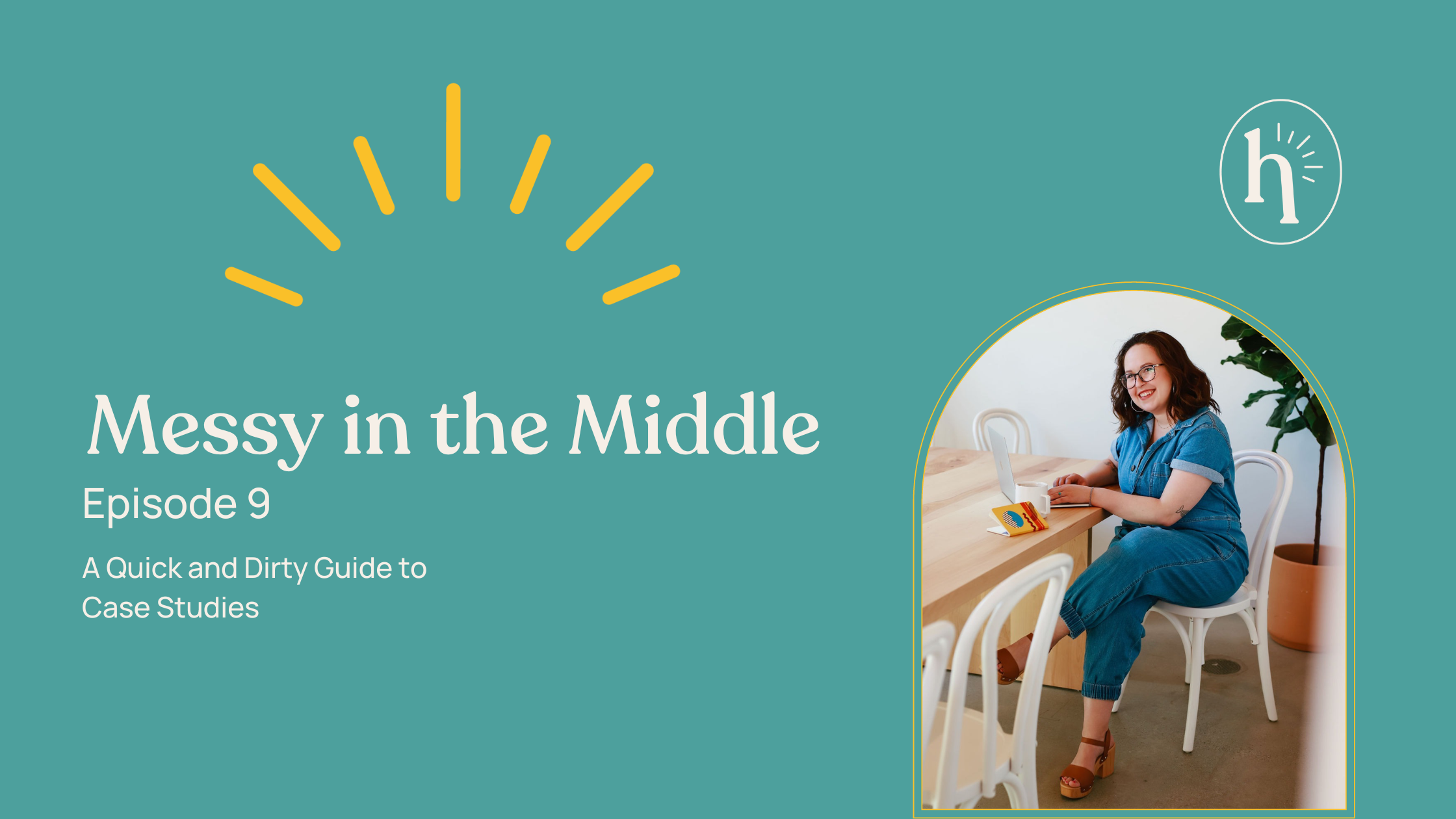Today we are going to be talking all about case studies- who they’re for, the role that they can play in your sales process, and how the heck to go about writing one in the first place!
What is a Case Study?
Let’s start at the beginning. What the heck is a case study?
To answer this question, let’s zoom out a little further and talk about sales pages. A sales page is an amazing tool to highlight the features and benefits of your course, program, or service, and so is a case study. The difference, however, between a sales page and a case study is that sales pages lack one major thing: context.
A well written sales page will take the reader on a journey of their own possibility. They’ll think about their current situation, imagine a life after the solution they desire, and then be guided by you, the service provider, through the process of getting to their desired state from their current one. Sales pages written in this way are very effective, but they require the reader, aka your potential buyer, to do a lot of work as they imagine themselves going through this transformation.
A case study, on the other hand, will take the reader through the journey of someone else’s experience, helping them to truly connect with the possibility of their transformation by experiencing that journey alongside someone who has been in their shoes before. Where sales pages tend to lead with facts, case studies lead with feelings. Guiding your readers through the transformation you provide, all in the words of your happy client or customer.
Case studies dive deeper into the before, during, after experience, even if that means highlighting a messy middle that a sales page would otherwise overlook of someone who needed your offer, sought out that offer and said, “heck, yes” to working with you, and then came out the other side with a stunning transformation. A case study gives the reader the context that they need to see that this experience is possible for them, too.
Who is a Case Study For?
Now that we know what a case study is, we can begin to dissect who is best served by having a case study as an opt-in or feature on your website. In my experience, case studies serve high ticket service providers, coaches, and consultants better than any other type of provider. This is because when you provide a service at a higher cost, the transformation tends to be more impactful than you can really convey in a simple sales page. And the ideal client or customer may need a bit more hand holding to be ready to purchase than if you had a lower ticket offer, because there is a more abstract transformation and maybe a little bit more at stake financially.
Case studies facilitate this hand holding by showcasing other happy clients or customers who may have been in a similar situation to your potential clients. Reading the case study is like getting a recommendation from a trusted friend versus just googling a restaurant and discovering that there are no reviews anywhere. You’re much more likely to trust the recommendation than the restaurant website. Or at least I am.
This is not to say that other providers can’t benefit from case studies, but if you fall into one of the categories mentioned above, it’s a pretty safe bet that a case study is a good next move for you to make. If you’re listening to this episode and thinking a case study might not be right for you, I encourage you to head over to Haleyejohnson.com/quiz to uncover which opt in is right for your business, your audience, and your goals.
How Do I Write A Case Study?
If you’re thinking, “I already know what a case study is, how the heck do I write one,” do not worry, I’ve got you covered. Figuring out how to write a case study is often a not so fun experience. Different industries have different standards for writing case studies, and simply googling how to write a case study can send you down a rabbit hole of advice that is less than helpful. So, I’m going to break it down for you as cut and dry as I can.
At its core, a case study has three main components: an introduction, where the writer sets the stage for the case study struggle. What was the client or customer experience before they decided to pursue the solution? A middle section, where the writer introduces the solutionand shows the experience of the user or client for students going through the steps of the solution. They had a struggle, they sought out a solution. What did that solution provide logistically? What did that feel like? What was that experience like? And then there’s a conclusion which shows the reader what life is like on the other side of the case study struggle now that the solution has been implemented. What does that transformation actually look like? And what does it feel like or accomplish for the buyer?
In some industries like marketing, where it is really easy to show progress through facts, figures and statistics, or branding, where a visual before and after can often speak for itself, writing these case studies is as quick of a process as listening to this podcast episode. But if you want to dig even deeper and create an experience for your reader, an interview based case study is the way to go.
You can conduct your interview however feels best for you, or if you’re shy or just don’t have time to ask your clients to wax poetic about how much they love you, you can hire someone else to do the interview for you.
How to Conduct the Interview
Here is a basic framework.The first step to interviewing a case study subject is the simplest, but it’s also the most nerve wracking.You have to ask, but I promise you, you are amazing and your clients love you. So, they will probably say yes. Just send a simple email along the lines of “hey, I loved working with you and would love to feature your experience, do you have time for a quick interview?” You can say it however you want, but this is a good starting point because it gets to the point. It’s super simple, easy to understand, and most importantly, it’s easy for your past client to want to say yes to. They don’t have to write anything, they don’t have to fill out a form. They just have to hop on a quick call and they hopefully already like talking to you.
Then we get to the actual interview. There are three key components to a case study: the before, the experience, and the transformation. We start at the beginning. Ask your case study subject what they were feeling before they decided to work with you? Did they have a conflict that they were working to resolve, a struggle they wanted to overcome? What did they try to do to solve the problem, resolve the conflict, or keep the struggle at bay? Did it work? What made them keep looking for a solution? What made them choose you? What is it about your solution, your offer, your client experience that made your case study subject say hell yeah to working with you. Why are you different? What made you stand out? You might have your own answers to these questions, but if you ask your interviewee, their answers might surprise you.
Then we get to that second stage, the experience. What did working with you feel like? How did your experience meet their expectations? How did it exceed them? If you’re looking for feedback, you can also ask if there were any places where you failed to meet expectations. But that’s not necessarily the purpose of this interview, so we’re not going to talk about that right now. What made working with you an experience worth talking about, a transformation worth sharing, a lesson worth learning?
And then we get to that conclusion stage. How much time has passed since you worked together? What have they learned in that time? How have they or their business changed? Gotten better, grown? What did working with you give them that they didn’t have before.These are the types of questions that I ask of my ideal clients when we work together for a case study project.
After the Interview
Working together and getting a testimonial is such a great accomplishment, but seeing someone go through the case study experience is so much more than that. It’s emotional, transformative, and truly spectacular. If you think about this framework, you can totally accomplish it.
After the interview, you will have everything you need to write the case study of your dreams. And if you don’t want to write a case study yourself, you can hire me to do it for you! Just head to haleyejohnson.com/contact, fill out the form with ‘Case Study’ as your message, and I will be in your inbox, ready to help your clients sing your praises in no time.
If you’re still not totally getting the picture of what a case study looks like, you check out one of my favorite client case studies and see for yourself. Finally, if you are looking to DIY, head on over to haleyejohnson.com/quiz, and if a case study is right for you, you’ll be guided through an email sequence that helps you out every step of the way!




